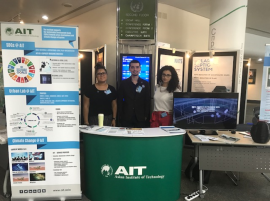
8 September 2017, Bangkok
The first Asia-Pacific Ministerial Summit on the Environment took place in Bangkok from 5-8 September 2017. The Ministerial Summit, jointly organized by the United Nations Economic and Social Commission for Asia and the Pacific (UN ESCAP) and the United National Environment Program (UN Environment), focused on addressing the linkages between resource efficiency and pollution reduction in Asia and the Pacific under the theme “Towards a Resource-efficient and Pollution-free Asia Pacific.“
The Summit adopted the Ministerial Declaration on environment and development for Asia and the Pacific, which is an important cornerstone of regional collaboration on sustainable management of natural resources in Asia and the Pacific and brings together the vision of our member States on future collaboration, particularly for the management of natural resources.
High-level officials from over 30 countries in the region, including ministers from Armenia, Bangladesh, Bhutan, DPR Korea, Fiji, Kazakhstan, Kiribati, Lao PDR, Maldives, Mongolia, Myanmar, Nepal, Samoa, Singapore, Solomon Islands, Sri Lanka, Timor-Leste, Tonga, Vanuatu, Viet Nam and Cook Islands attended the Summit.
The Asian Institute of Technology (AIT) participated in the “Pavilion of Partnerships for Environment and Development” to showcase the diverse portfolio of AIT expertise, research capabilities and outreach activities. The AIT Exhibit was coordinated by the AIT Solutions (AITS) in support from the Geo-Informatics Center (GIC), Naturally Acceptable and Technological Sustainable (NATS) Toilets, Regional Resource Center for Asia and the Pacific (RRC.AP), Office of the Vice President for Development (VPD), and Yunus Center at AIT (YCA). The Office for External Relations (OEXR) made the AIT Roadshow Kit available for the Exhibit.
The unified representation of AIT generated significant level of interest amongst the attendees of the summit and from the various United Nations agency representatives. Participation at the event also helped raise AIT’s profile amongst the government representatives and development partners.
This joint participation also facilitated opportunities for collaboration with different stakeholder organizations in partnership with centers in AIT on complementary areas of work.


